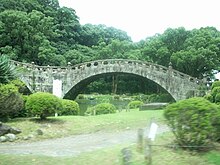Isahaya Park
The Isahaya Park ( Japanese 諫 早 公園 , Isahaya-kōen ) is a park in the Takashiro-machi district of Isahaya in the Japanese prefecture of Nagasaki .
It is bounded by the Honmyō River in the north, the Takashiro Shrine ( 高 城 神社 , Takashiro-jinja ) in the east and the Shimabara Tetsudō railway line in the south, on the opposite side of the Tenryū Temple ( 天祐 寺 , Tenryū-ji ) in the southeast and the much larger Jōyama Park ( 上山 公園 , Jōyama-kōen ) are in the southwest.
It was created on the ruins of Isahaya Castle (also called Takashiro) during the Taishō period .
The park is known for its azalea blossoms and the venue for the annual “ Azalea Festival” ( 諫 早 公園 つ つ じ 祭 , Isahaya-kōen Tsutsuji Matsuri ) and for the Megane Bridge ( 眼鏡 橋 , Meganebashi , dt. “ Glasses Bridge”).
Megane Bridge
The massive stone double arch bridge was built in 1839 to replace the previous bridges that were damaged or washed away in the annual floods of the Honmyō. It was completed within 18 months based on the model of the Meganebashi in Nagasaki and is 49.25 m long, 5.5 m wide and consists of 2,800 stones.
On July 25, 1957, there was a record flood that hit the entire city. While the bridge survived the flood with only minor damage, it was considered to be the reason that the floating debris left on it had dammed the river even more and increased the tide. Therefore, the building ministry wanted to have the bridge blown up. The city administration prevented this by registering the bridge as a national cultural asset . The application was granted in November 1958 and the Megane Bridge became the first stone bridge in Japan with this status. The bridge was then moved to its current position in the park and spans a pond there today.
Individual evidence
- ↑ a b 人 々 が 願 っ た 永久 不 壊 の 橋 ・ 静 か に 歴 史 を 語 る 眼鏡 橋 . Isahaya, accessed December 4, 2011 (Japanese).
Coordinates: 32 ° 50 ′ 42 " N , 130 ° 2 ′ 52" E
